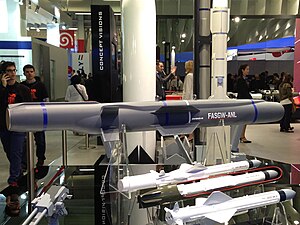| Sea Venom Anti-Navire Léger | |
|---|---|
 | |
| Type | Anti-ship missile |
| Place of origin |
|
| Service history | |
| In service | 2026 (Royal Navy - projected) |
| Used by |
|
| Production history | |
| Manufacturer | MBDA |
| Specifications | |
| Mass | 120 kg (260 lb) |
| Length | 2.5 m (8 ft 2 in) |
| Diameter | 200 mm (7.9 in) |
| Warhead | HE semi‐armour piercing blast/fragmentation |
| Warhead weight | 30 kg (66 lb) |
Detonation mechanism | Impact, time delay |
| Engine | Two‐stage solid‐propellant rocket motor |
Operational range | > 20 km (11 nmi; 12 mi) |
| Maximum speed | Mach 0.85 (289 m/s; 949 ft/s) |
Guidance system | INS, IIR |
Launch platform | |
| References | Janes[1] |
Sea Venom is an Anglo-French lightweight anti-ship missile developed by MBDA to equip the French Navy and the Royal Navy.[2] The missile is known as Anti-Navire Léger (ANL) in France and Sea Venom (formerly "Future Anti-Surface Guided Weapon (Heavy)") in the United Kingdom. While initial operating capability had been expected with the Royal Navy in 2022, it was reported in 2023 that, due to "on-going integration challenges", the Royal Navy's Wildcat helicopters would only achieve full operational capability with the missile in 2026.[3][4][5][6][7] The first test launch, from an AS365 Dauphin helicopter of the French DGA, was successfully conducted on 21 June 2017.[8][9]
- ^ Janes (21 November 2022), "Sea Venom/ANL (FASGW[H]/ANL)", Janes Weapons: Air Launched, Coulsdon, Surrey: Jane's Group UK Limited, retrieved 2 January 2023
- ^ "SEA VENOM-ANL" (PDF). MBDA. Archived from the original (PDF) on 8 November 2014. Retrieved 12 December 2014.
- ^ "Royal Navy's Sea Venom light anti-ship missile full operating capability delayed until 2026". Navy Lookout. 21 June 2023.
- ^ "RN Wildcats field new anti-surface guided weapons for CSG21".
- ^ "The Martlet missile – the Wildcat helicopter gets its claws". www.navylookout.com. 15 June 2020.
- ^ "FASGW(H) / ANL" (PDF). Archived from the original (PDF) on 3 August 2014. Retrieved 12 December 2014.
- ^ Richard Scott (17 December 2018). "Sea Venom/ANL missile service entry faces year-long delay". IHS Janes. Retrieved 18 December 2018.
- ^ Hoyle, Craig (5 July 2017), "Anglo-French anti-ship missile completes first test", Flightglobal.com